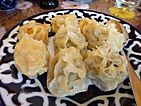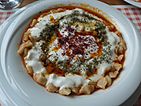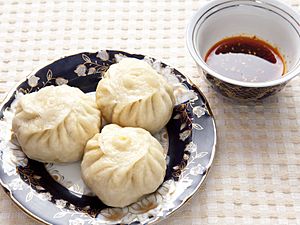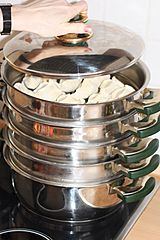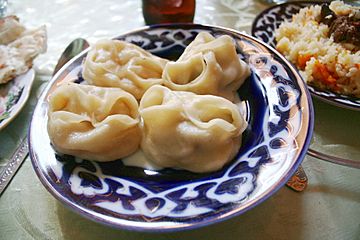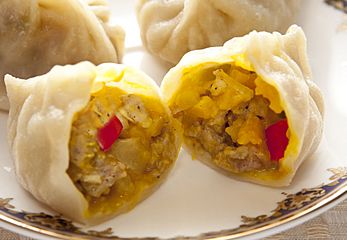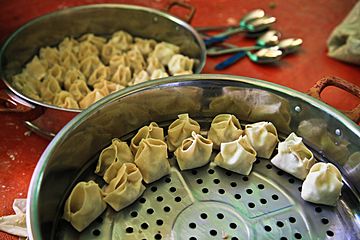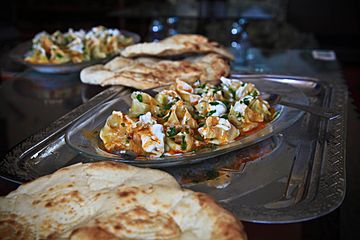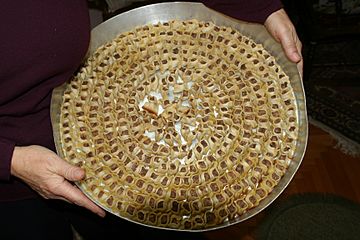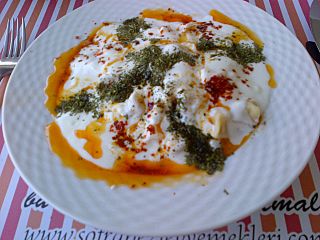Manti (food) facts for kids
|
Uzbek manti (left) and Turkish Kayseri manti (right)
|
||||
| Alternative names | Manty, mantu, manta, mantı | |||
|---|---|---|---|---|
| Type | Dumpling | |||
| Region or state | East Asia, Central Asia, South Caucasus | |||
| Main ingredients | Spiced meat (lamb or ground beef), dough | |||
| Ingredients generally used | Yogurt, garlic | |||
| Variations | Hingel, mataz, khinkali | |||
Manti is a yummy type of dumpling that's popular in many parts of the world! You can find it in places like the South Caucasus (near the Black Sea), the Balkans (Southeast Europe), Central Asia, and Afghanistan. It's also a favorite among Chinese Muslims and in countries that used to be part of the Soviet Union.
These tasty dumplings usually have a spiced meat filling, often lamb or ground beef. This filling is wrapped in a thin sheet of dough. Then, the manti are either boiled or steamed until they are cooked perfectly. The size and shape of manti can be very different depending on where you are in the world!
Manti is quite similar to other dumplings from Asia. For example, it's like the Chinese jiaozi and baozi, Korean mandu, Mongolian buuz, and Tibetan momo. The name "manti" is even related to the Chinese word "mantou" and the Korean "mandu."
The word "manti" can mean one dumpling or many dumplings, depending on the language. In English, we often use "manti" for both singular and plural.
Contents
The Story of Manti: Where Did It Come From?
The exact origin of the word "manti" is a bit of a mystery. Some people think it comes from the Chinese word mantou. In ancient China, during the Jin dynasty (266CE–420CE), there were records of a food called mantou that was filled with meat. Over time, the meaning of mantou changed in most parts of China to mean a plain steamed bun, while meat-filled ones became known as baozi.
Some of the earliest mentions of dishes that look like manti come from the time of the Mongol Empire. A book from 1330, written by a Chinese court therapist, mentions a dish called manta. It's believed that different versions of manti might have started with the Uyghur people in northwest China.
Many experts agree that the recipe for manti traveled across Central Asia along the famous Silk Road. This journey brought the dish to places like Anatolia (modern-day Turkey) thanks to Turkic and Mongol groups. Imagine horsemen carrying frozen or dried manti that they could quickly boil over a campfire!
One researcher suggests that manti first arrived in Cilician Armenia because Armenians and Mongols were allies in the 13th century. When Turkic-speaking people moved to Anatolia, the dumpling changed and became the Turkish mantı. The Tatar people, who settled in the Kayseri region of Turkey, made the area famous for its manti. Korean mandu is also thought to have arrived in Korea through the Mongols in the 14th century.
However, some researchers also think that manti might have started in the Middle East and then spread eastward to China and Korea along the Silk Road.
One of the first written recipes for Ottoman mantı appeared in a cookbook from the 15th century. This version was a steamed dumpling filled with minced lamb and chickpeas, spiced with cinnamon, and served with a garlic-yogurt sauce.
Manti in Central Asia: Steamed and Savory
In Central Asian cuisines, manti are usually bigger. They are cooked in a special multi-level steamer called a mantovarka or mantyshnitsa. This steamer has layers of pans with holes, placed over a pot of boiling water. Steaming is the main way to cook manti here. If they are boiled or fried, they are usually called a different type of dumpling, like pelmeni.
In Kazakh cuisine and Kyrgyz cuisine, manti are often filled with minced lamb (sometimes beef or horse meat). They are spiced with black pepper and sometimes have chopped pumpkin or squash added. This is a traditional Uyghur recipe. Manti is served with butter, sour cream, or a special onion sauce or garlic sauce. If you buy manti as street food in Kazakhstan or Kyrgyzstan, they often come sprinkled with hot red pepper powder.
In Uzbek and Tajik cuisines, manti can be filled with lamb, beef, cabbage, potato, or pumpkin. Meat manti often have extra fat added. They are usually topped with butter and can be served with sour cream, different kinds of ketchup, or fresh onions (with vinegar and black pepper). A sauce made from vinegar and chili powder is also common. Bukharian Jews sometimes use cheese fillings, and these dumplings are usually served with yogurt. In Uzbekistan, manti are also called kaskoni.
This steaming style of manti is also traditional for Tatar, Bashkir, and other Turkic peoples living across a huge area, including Russia and other post-Soviet countries.
-
Uzbek manti
Manti in Afghanistan: Rich Sauces and Unique Shapes
In Afghan cuisine, the thin dough of mantu (as it's called there) is filled with beef or lamb mixed with minced onions and spices. After steaming, it's topped with a creamy yogurt sauce called seer mosst (which means "garlic yogurt"). This sauce is made with thick, strained yogurt, lemon juice, dried and fresh mint, chili powder, and crushed garlic.
Mantu can also have a tomato-based sauce, which might include split peas, red kidney beans, or sautéed ground meat. The type of meat in the sauce often matches the meat in the dumpling filling. Usually, there's more yogurt sauce than tomato sauce, and it's dotted on top rather than covering the whole dish. Sometimes, extra bowls of the meat and tomato sauce and the yogurt sauce are kept on the table. Some Afghans also enjoy serving mantu with a carrot qorma (a type of stew) instead of a tomato sauce.
Authentic Afghan mantu dumplings are meant to be small and bite-sized. The dough is rolled very thin so it's not chewy. There's a special way the dough is twisted and closed around the filling. There's also a similar Afghan dish called Aushak, which has a different filling and is boiled instead of steamed.
-
Afghan dish of mantu
Manti in Armenia and Turkey: Boiled, Baked, and Tiny!
Unlike the Central Asian versions, manti in Anatolia (Turkey) and Transcaucasia (like Armenia) are usually boiled or baked. They also tend to be much smaller. In modern Turkish cuisine, mantı is typically served with yogurt and garlic, spiced with red pepper powder and melted butter. People often add ground sumac and/or dried mint on top.
Similarly, Armenian manti, sometimes called monta, are usually served with yogurt (matzoon) or sour cream (ttvaser) and garlic, often with a clear soup called mantapour. Armenian manti is unique because it's always baked and crunchy, never just steamed or boiled, whether served with yogurt or not.
A very popular type of Turkish mantı is called Kayseri mantısı, named after the city of Kayseri. These are tiny dumplings served with yogurt, melted butter (often flavored with spearmint or Aleppo pepper), and topped with dry mint and Aleppo pepper flakes. In some parts of Turkey, manti can even be made with shredded quail, chicken, or goose meat. There's also boş mantı ("empty dumpling"), which has no filling at all!
Turkish cuisine also has other dumplings similar to manti, like hingel and Tatar böreği. These are usually larger than Kayseri mantısı.
-
Baked Armenian manti
-
Turkish mantı with melted butter, garlic-yogurt sauce and Aleppo pepper
Manti in Bosnia: Klepe and Mantije
In Bosnian cuisine, manti-like dishes are called klepe or kulaci. These are made with minced meat and onions. They are served with a sauce made of yogurt and garlic.
There's also a separate dish called mantije. This is made with the same ingredients, but the pastry balls are placed very close together and baked. After baking, yogurt is poured on top. This second type is often seen as a kind of pita or burek rather than a true manti. It's mostly made in the Sandžak region and in Kosovo.
Different Names for Manti
This delicious dish is known by many names!
- Manti in Armenian (մանթի), Azerbaijani (mantı), Kazakh (мәнті/mänti), Turkish (mantı), and Uzbek (manti/monti).
- Manty in Kyrgyz, Tatar, and Russian (манты).
- Mantu in Pashto, Persian, and Arabic (منتو); and Tajik (манту).
- Manta in Uyghur (مانتا, monta) and Mongolian (мантуу).
See also
 In Spanish: Mantı para niños
In Spanish: Mantı para niños


